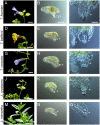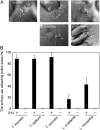Species preferentiality of the pollen tube attractant derived from the synergid cell of Torenia fournieri
- PMID: 16935992
- PMCID: PMC1586061
- DOI: 10.1104/pp.106.083832
Species preferentiality of the pollen tube attractant derived from the synergid cell of Torenia fournieri
Abstract
The synergid cell of Torenia fournieri attracts pollen tubes by a diffusible but yet unknown chemical attractant. Here we investigated the species difference of the attractant using five closely related species in two genera, namely T. fournieri, Torenia baillonii, Torenia concolor, Lindernia (Vandellia) crustacea, and Lindernia micrantha. These five species have an exserted embryo sac, and ablation experiments confirmed that their synergid cells attracted the pollen tube. When ovules of T. fournieri and one of the other species were cultivated together with pollen tubes of each species, pollen tubes were significantly more attracted to synergid cells of the corresponding species. The attraction was not affected by the close proximity of embryo sacs of different species. This suggests that the attractant is a species-preferential molecule that is likely synthesized in the synergid cell. The calcium ion, long considered a potential attractant, could not serve as the sole attractant in these species, because elevation of the calcium ion concentration did not affect the observed attraction. In vivo crossing experiments also showed that the attraction of the pollen tube to the embryo sac was impaired when pollen tubes of different species arrived around the embryo sac, suggesting that the species preferentiality of the attractant may serve as a reproductive barrier in the final step of directional control of the pollen tube.
Figures








References
-
- Chaubal R, Reger BJ (1990) Relatively high calcium is localized in synergid cells of wheat ovaries. Sex Plant Reprod 3: 98–102
-
- Chaubal R, Reger BJ (1992. a) Calcium in the synergid cells and other regions of pearl millet ovaries. Sex Plant Reprod 5: 34–46
-
- Chaubal R, Reger BJ (1992. b) The dynamics of calcium distribution in the synergid cells of wheat after pollination. Sex Plant Reprod 5: 206–213
-
- Chaubal R, Reger BJ (1993) Prepollination degeneration in mature synergids of pearl millet: an examination using antimonite fixation to localize calcium. Sex Plant Reprod 6: 225–238
-
- Cheung AY, Wang H, Wu HM (1995) A floral transmitting tissue-specific glycoprotein attracts pollen tubes and stimulates their growth. Cell 82: 383–393 - PubMed
Publication types
MeSH terms
Substances
Associated data
- Actions
- Actions
- Actions
- Actions
- Actions
- Actions
- Actions
LinkOut - more resources
Full Text Sources

